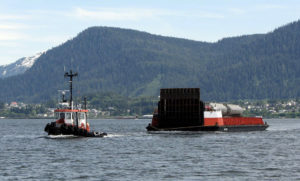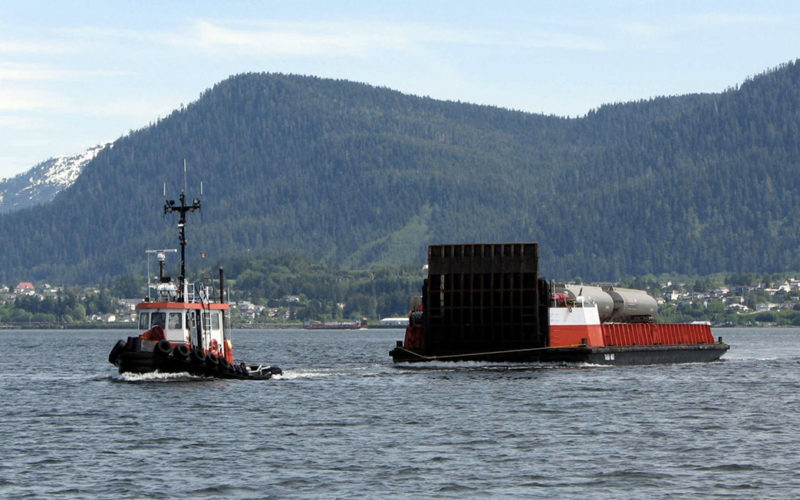Two mariners died and a third suffered serious injuries after their tugboat sank in a remote British Columbia waterway during a strong winter storm.

Capt. Troy Pearson and deck hands Charley Cragg and Zac Dolan were aboard the 36-foot Ingenika when it capsized in the Gardner Canal near Kemano while towing the 200-foot barge Miller 204. The tug’s emergency beacon activated at 0040 on Feb. 11 about 16 nautical miles north of Gribbell Island.
The Royal Canadian Mounted Police (RCMP) vessel Inkster responded to the distress signal from nearby Hartley Bay. Inkster’s crew found Cragg deceased, and the Canadian Coast Guard later recovered Pearson’s body. A private helicopter found Dolan, 19, alive on the shore and transported him to a hospital. Authorities did not specify the nature of his injuries.
Canada’s Transportation Safety Board (TSB) is investigating the incident, but a final report will likely take at least a year to produce. In March, the agency said it was expanding the scope of its investigation due to the “potential for yielding safety lessons,” a spokeswoman said.
At press time in late March, the TSB had not released additional information about the incident. Ingenika, operated by Wainwright Marine Services of Prince Rupert, remained on the seafloor in an unidentified location in Gardner Canal.
Ingenika left Kitimat at about 1600 on Feb. 10 with Miller 204 in tow off the stern. The vessels were headed for Kemano Bay, home to a large hydropower plant, to discharge a cargo of construction equipment. Weather conditions that night were frigid, with temperatures dipping below zero degrees Fahrenheit and winds gusting beyond 60 mph.
It’s not clear what happened aboard the tugboat or what trouble the crew encountered. Authorities have not specified when or where Pearson and Cragg were found, or where Dolan was when help arrived. All three were wearing survival suits. It is not known if the crew deployed a life raft or issued a mayday call.
Search teams found Miller 204 aground roughly 4 miles from the tug’s last known location in Gardner Canal.
Judy Carlick-Pearson, the widow of the captain, is urging Canadian authorities to locate and raise the tugboat. She believes the vessel will contain key clues about what happened on its final voyage.
“We need that vessel salvaged because we still have no real concrete answers,” she said in a recent phone interview. “We don’t know … if there were instability issues or if there were structural issues or any mechanical issues. We don’t know that.”
Carlick-Pearson has launched a petition campaign urging the Canadian government to salvage the tug, and Cragg’s family wants the vessel raised for the same reasons, according to Canadian media accounts. As of late March, nearly 12,000 people had signed a petition asking for the vessel to be salvaged as part of the investigation.
Canadian authorities have not committed to that effort. The RCMP’s Marine Division deployed a remotely operated vehicle (ROV) after the incident to try to locate the sunken vessel. The ROV followed the tug’s apparent path to a depth of 565 feet without finding it, Transport Canada spokeswoman Frederica Dupuis told Professional Mariner.
“The suspected depth of the vessel would make any attempts at recovery difficult and very dangerous,” Dupuis said.
Carlick-Pearson raised questions about the 700-hp Ingenika performing such a tow with its low freeboard “in some of the sketchiest channels in Canada.” She said this type of tow was standard for Ingenika but relatively rare for similarly sized tugs in British Columbia.
Wainwright Marine Services did not respond to inquiries about the incident or the makeup of the tow.
Canadian regulations did not require Ingenika to be inspected. “This tug was under 15 gt in size and therefore was not required by regulations to be inspected, but (it was) required to meet the standards set out in the Canada Shipping Act 2001 and associated regulations applicable to vessels of its type and size,” Dupuis said.
Pearson, 57, lived in Prince Rupert with his wife and 12-year-old son Carver. Pearson joined his dad on fishing vessels as a child and by age 15 was earning a full share on a commercial fishing vessel. He later worked for BC Ferries and owned a sportfishing business before joining Wainwright in 2017. He was promoted to captain in 2019.
“He was probably one of the most methodical, cautious people around, and he never in 25 years put myself, my son or anyone in danger,” Carlick-Pearson said, describing her husband as diligent and well-prepared. “I don’t think he ever said no to a job. He was a true mariner.”
Cragg, 25, grew up near Vancouver and had recently moved to Terrace, British Columbia, according to news accounts in Canada. He grew up around boats, but the accident voyage was his first time working on a tug, Carlick-Pearson said. Attempts to reach Cragg’s family were not successful.
“Charley was a mariner,” his family said in an obituary. “He loved the ocean and everything she had to offer. His zest for life and adventure whether at sea or in the mountains was who he was to the core.”
Carlick-Pearson is mourning her husband and still seeking closure. She believes raising the vessel could lead to new regulations that protect other mariners from the same fate.
“If something is not done about it now,” she said, “do we wait until the next big accident to happen and then try to look at it again?”

